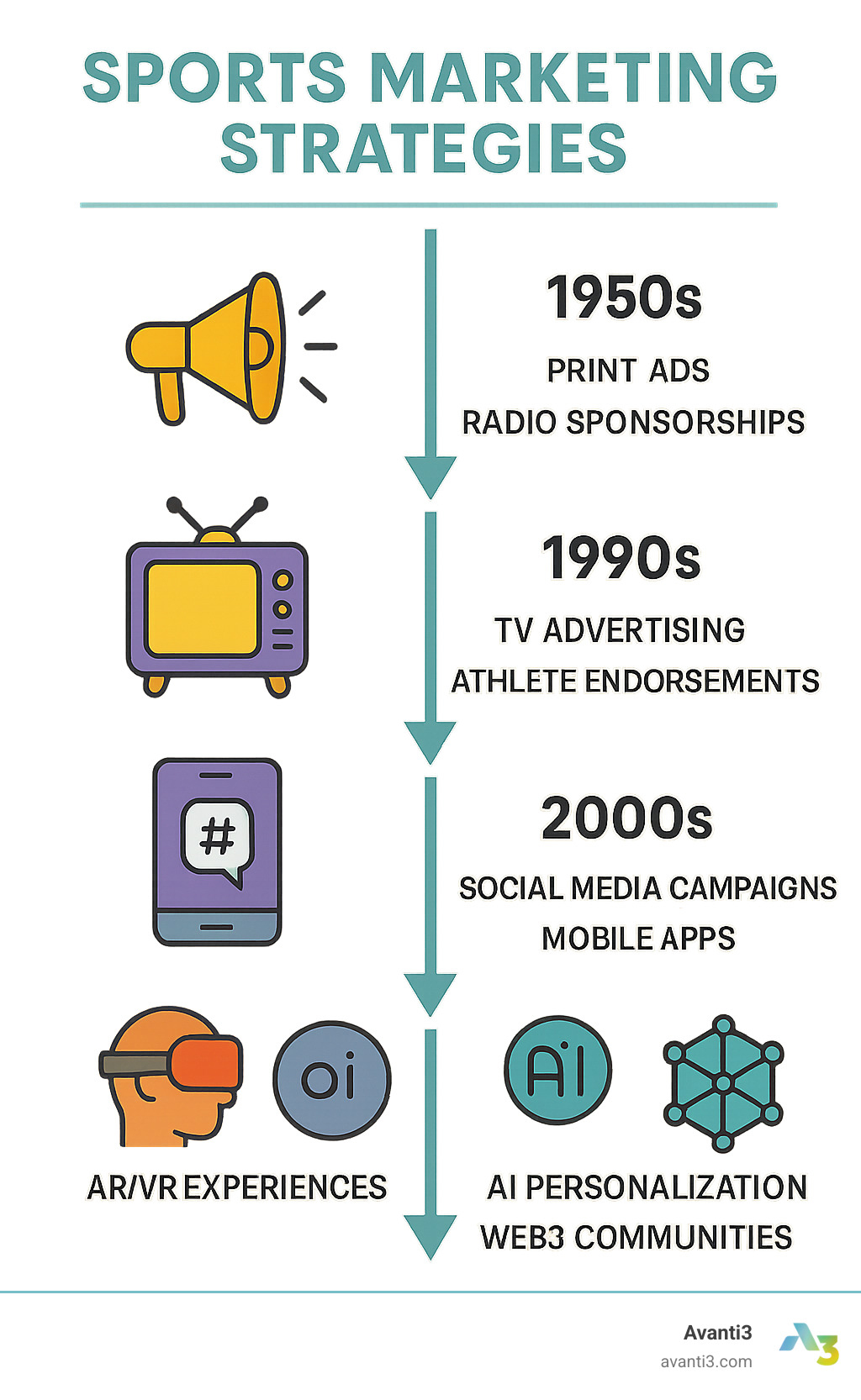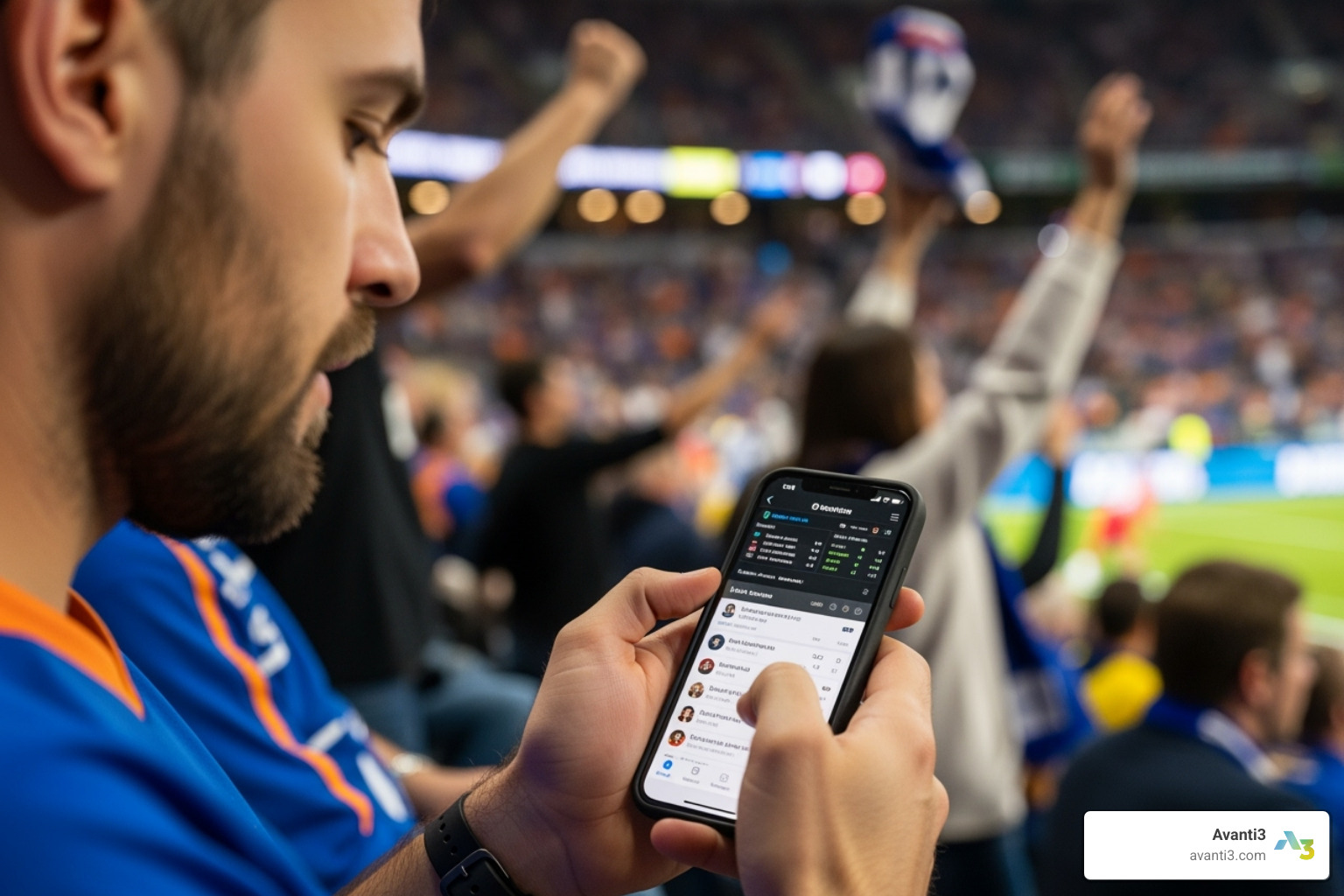Sports Marketing Strategies: 10 Essential Wins
Why Sports Marketing Strategies Are Essential for Success
Sports marketing strategies are crucial for building lasting connections between brands, teams, and their passionate fan bases. Whether you’re promoting professional leagues, sponsoring local events, or engaging with esports communities, the right approach can transform casual viewers into devoted supporters who drive revenue and brand loyalty.
Core Sports Marketing Strategies:
- Athlete Endorsements – Partner with influential players to build credibility
- Social Media Engagement – Create compelling content across platforms (27% of fans use Facebook, 23% use YouTube)
- Local Sponsorships – Build community goodwill through grassroots partnerships
- Gamification – Use interactive elements like fantasy leagues and loyalty programs
- Digital Innovation – Leverage AI, AR/VR, and Web3 technologies for immersive experiences
The sports industry generates $1.3 trillion worldwide, making it one of the largest entertainment sectors globally. This massive market offers unprecedented opportunities for brands willing to invest in authentic fan relationships.
Modern sports marketing has evolved far beyond traditional stadium billboards and TV commercials. Today’s successful campaigns blend emotional storytelling with cutting-edge technology to create personalized experiences that resonate with diverse audiences across multiple touchpoints.
The most effective sports marketing strategies tap into the powerful emotional connections fans have with their teams. As Steve Jobs once noted about Nike’s advertising approach, it’s about “honoring great athletes and great athletics” rather than just selling products.
I’m Samir ElKamouny AV, and I’ve helped businesses scale through strategic marketing that prioritizes authentic connections and innovative engagement. My experience in developing sports marketing strategies has shown me that the most successful campaigns combine traditional relationship-building with modern technology to create lasting fan loyalty.

Sports marketing strategies terms simplified:
Foundational Strategies: Building Your Playbook

Building sports marketing strategies is like creating a championship playbook. Just as a team needs a game plan, so does your marketing.
Your playbook needs three core components: understanding your audience inside and out, building a brand identity that sticks, and creating real connections that go beyond the scoreboard. This isn’t just about winning games – it’s about building a community where fans feel like they’re part of something bigger.
The magic happens when you weave your story into fans’ daily lives, turning casual viewers into supporters who show up rain or shine.
Using the Power of Athlete and Influencer Endorsements
Let’s talk about the heavyweight champion of sports marketing strategies: athlete endorsements. When done right, they’re pure marketing gold.
Take Michael Jordan’s Nike partnership. Back in 1984, Nike offered him a five-year deal worth $2.5 million. Sounds pretty good, right? Here’s the kicker – Nike now makes $3 million in Jordan sales every five hours. That’s what we call a slam dunk investment.
But here’s the thing – not every brand has Super Bowl ad money (which hit $7 million for thirty seconds in 2023). That’s where influencer marketing steps in as your secret weapon. Social media influencers with engaged niche audiences can pack just as much punch as big-name athletes, often at a fraction of the cost.
The key word here is authenticity. Fans can smell a fake endorsement from miles away. When a super-fit athlete tries to sell fast food, it just feels wrong. The best partnerships happen when the athlete’s values and your brand’s message align naturally.
Best practices mean finding that sweet spot where everything clicks. The athlete’s audience should overlap with your target market. Their personal brand should complement yours. And most importantly, the partnership should tell a story that fans actually want to hear.
Of course, there are pitfalls to avoid. Endorsements can backfire spectacularly if an athlete’s image takes a hit or if the partnership feels forced. That’s why we focus on building genuine relationships rather than just writing checks.
At Avanti3, we understand how digital brand engagement can make or break these partnerships. We help creators and brands craft customizable engagement tools that ensure every endorsement resonates with the right audience.
Engaging Fans Through Compelling Social Media Content
Social media is where sports marketing strategies come alive. It’s the digital stadium where fans gather 24/7, and you need to be there with them.
The numbers tell an interesting story: 27% of sports fans use Facebook for additional content, 23% turn to YouTube, and 15% scroll through Instagram. But here’s what’s really important – each platform serves a different purpose in your playbook.
Storytelling is what separates great social media from boring score updates. Fans crave those behind-the-scenes moments that make them feel like insiders. Show them the locker room pep talks, the pre-game rituals, the human side of their heroes.
User-generated content is your secret sauce. When fans share their own game-day experiences, reactions, and photos, they’re doing your marketing for you – and it’s way more believable than anything you could create in a boardroom.
Different leagues have their own social media personalities. MLS and WNBA fans are social media champions, placing 50% more importance on updates than other league fans. They’re also the most likely to join off-season events, making them perfect for year-round engagement.
NBA fans love online communities and interactive discussions. NHL fans still prefer team websites for official updates, while NFL fans are fantasy sports obsessed – they want 25% more fantasy-related content than fans of other leagues.
Understanding these differences helps you speak each fanbase’s language. At Avanti3, our digital community building tools help you create those vibrant online spaces where fans want to hang out.
Dominating the Local Scene with Sponsorships
While the big leagues get attention, some of the smartest sports marketing strategies happen locally. Local sponsorships might not make ESPN highlights, but they build something more valuable: genuine community connections.
Youth sports sponsorships are marketing goldmines. You’re not just putting your logo on a jersey; you’re investing in kids’ futures while connecting with families who’ll remember your support for years to come.
The beauty of local sponsorships lies in their authenticity. When you sponsor the neighborhood Little League team, you’re not just another corporate name – you’re part of the community fabric. Parents see your brand every practice, every game, every team photo.
Community goodwill translates directly into customer loyalty. Local businesses that sponsor youth teams often see increased foot traffic, positive word-of-mouth, and stronger community ties. It’s relationship marketing at its finest.
Brand visibility works differently at the local level. Instead of competing with million-dollar campaigns, your sponsorship stands out in a smaller pond. A dugout banner or team uniform sponsorship can generate months of exposure for a fraction of what you’d pay for traditional advertising.
Event sponsorship opens even more doors. Sponsoring tournaments, award ceremonies, or end-of-season celebrations puts your brand front and center during memorable moments. These are the experiences families talk about around the dinner table.
At Avanti3, we provide tools on building community partnerships that help organizations connect with local businesses. We make it easy to create those win-win relationships where teams get the support they need and sponsors get genuine community engagement.
Advanced Sports Marketing Strategies for the Modern Era

The sports world is changing fast, and sports marketing strategies must keep pace. Gone are the days of simple billboards or TV ads. Today’s fans expect interactive experiences, personalized content, and technology that makes them feel part of the action, not just spectators.
Modern sports marketing isn’t about replacing traditional methods – it’s about enhancing them with digital innovation and smart use of fan data. We’re living in an era where a single tweet can reach millions, where virtual reality can transport fans to the front row, and where artificial intelligence can predict what each fan wants to see next.
Gamification: An Interactive Approach to Sports Marketing Strategies
Here’s something fascinating: sports fans are naturally competitive. They live for the thrill of victory and the agony of defeat. So why not tap into that competitive spirit with gamification? This approach transforms passive fans into active participants by adding game-like elements to their experience.
Think about it – sports are already games! Gamification mechanics simply extend that excitement beyond the final whistle. When fans earn points and rewards for attending games, buying merchandise, or sharing content on social media, they’re not just consuming sports – they’re participating in them.
The MLB’s Ballpark app is a perfect example. Fans rack up points for showing up to games and making purchases, then redeem those points for exclusive perks. It’s brilliant because it rewards the behavior teams want to see more of.
Fantasy leagues take this concept even further. The World Surf League’s fantasy platform lets fans build their dream teams and compete against friends. Suddenly, every competition matters more because fans have skin in the game. They’re not just cheering for their favorite surfer – they’re invested in multiple athletes across the entire league.
Even simple quizzes and polls during live broadcasts can work magic. These interactive elements keep fans glued to their screens while providing valuable insights about their preferences. It’s a win-win that costs almost nothing to implement.
The beauty of gamification lies in the data it generates. Every interaction tells you something about your fans’ preferences, behaviors, and engagement patterns. This information becomes gold for future marketing campaigns.
At Avanti3, our community loyalty programs are designed to create these gamified experiences that turn casual fans into devoted community members.
The Art of Ambush and Parallel Marketing
Let’s discuss a controversial tactic in sports marketing strategies: ambush marketing. It’s like crashing a party—risky, but potentially rewarding if done right.
Ambush marketing involves associating your brand with a major sporting event without paying those eye-watering sponsorship fees. A thirty-second Super Bowl ad now costs $7 million! For brands that can’t afford official sponsorship, ambush marketing offers an alternative path to ride the wave of excitement.
The rewards can be substantial. Nike has famously used this tactic during Olympics, creating buzz without paying official sponsorship fees. Paddy Power has built a reputation for cheeky campaigns that steal attention from official sponsors during major tournaments.
But here’s the catch – the risks are equally significant. Official sponsors and event organizers don’t take kindly to brands muscling in on their territory. Legal considerations are serious, with potential lawsuits for trademark infringement or misleading consumers. One wrong move can damage your brand’s reputation permanently.
That’s where parallel campaigns come in as a safer alternative. Instead of directly referencing the event, smart marketers create campaigns that capture the cultural moment without stepping on legal landmines. A UK used-car website once offered free cars for every goal England scored during a major tournament. They never mentioned the specific event, but everyone knew exactly what they were talking about.
Major sporting events create cultural moments that extend far beyond the official sponsors. The key is being creative and subtle, focusing on the broader excitement without crossing legal boundaries.
At Avanti3, our digital engagement platforms help brands steer these complex waters, creating impactful campaigns that maximize reach while respecting legal boundaries.
eSports: The New Frontier for Sports Marketing Strategies
If you’re still thinking of eSports as kids playing video games in their bedrooms, you’re missing out on a massive opportunity. The eSports market is projected to grow to $7.1 billion by 2028, making it one of the fastest-growing segments in entertainment.
eSports market growth is reshaping what we consider “sports marketing.” This isn’t a niche anymore – it’s a global phenomenon with passionate fans who are just as dedicated as any traditional sports supporter.
The gamer demographics might surprise you. The average gamer is about 32 years old, with nearly equal gender representation. This challenges every stereotype about who plays games and opens up incredible opportunities for brands willing to accept this community.
But here’s the crucial part: authenticity matters more in eSports than almost any other marketing space. These communities have finely tuned radar for fake or forced marketing attempts. Brands must understand the culture, learn the language, and respect the specific nuances of different game genres.
Social viewing is central to the eSports experience. Platforms like Twitch and YouTube aren’t just broadcasting channels – they’re interactive communities where fans chat with streamers and each other in real-time. This creates unique opportunities for brands to engage in genuine conversations rather than just pushing one-way messages.
The grassroots scene is thriving too, with over 500 universities in the US now fielding their own eSports teams. This creates opportunities for community-level engagement that mirrors traditional college sports marketing.
Traditional sports marketers need to shed their preconceptions and accept the diverse, dynamic world of eSports. Understanding specific gaming communities is essential for success – what works for a first-person shooter audience might fall flat with strategy game fans.
At Avanti3, we recognize eSports as a vital frontier in modern marketing. Our platforms are perfectly suited to help brands connect with this rapidly growing audience through customizable engagement tools designed specifically for digital-native communities.
The Tech Revolution: AI, AR, and the Future of Fan Engagement

Technology is reshaping sports marketing strategies in unimaginable ways. Emerging technologies like Web3, AI, and AR/VR are changing how fans connect with teams and athletes. The global sports technology market is projected to reach $55.14 billion by 2030, growing at 20.8% annually.
This isn’t just about flashy gadgets or cool effects. It’s about creating deeper, more meaningful connections between fans and the sports they love. When we can use data-driven marketing to understand what makes each fan tick, we can deliver experiences that feel personal and authentic.
Personalizing the Fan Journey with AI
Artificial intelligence is becoming the secret weapon in modern sports marketing strategies. Think of AI as your super-smart assistant that never sleeps and remembers everything about every fan. It analyzes massive amounts of fan data – from what games they watch to which players they follow on social media – to create detailed profiles of each person.
Here’s where it gets really exciting. Personalized content means a basketball fan might wake up to custom highlights of their favorite player’s best dunks from last night’s game. A baseball enthusiast could receive perfectly timed updates about their team’s playoff chances. AI in sports can improve performance and strategy, but it also revolutionizes how we market to fans.
Targeted offers become incredibly precise when AI identifies patterns in fan behavior. Maybe it notices someone always buys tickets two weeks before games, or they tend to purchase jerseys right after big wins. AI can predict when fans are most likely to make purchases and send them exactly the right offer at the perfect moment.
The operational efficiency gains are huge too. AI can automatically update websites with schedules and stats, generate social media content ideas, and manage email campaigns. This frees up marketing teams to focus on creative strategy rather than repetitive tasks.
At Avanti3, our AI customer engagement solutions help teams and brands harness this power, ensuring every fan interaction feels personal and meaningful.
Creating Unforgettable Moments with AR/VR
Augmented Reality and Virtual Reality aren’t science fiction anymore – they’re creating real magic in sports marketing strategies right now. These technologies transport fans beyond the limitations of physical space and time, offering experiences that stick with them long after the game ends.
Virtual stadium tours let fans explore their team’s home venue from anywhere in the world. Imagine walking through the locker room where your heroes get ready for battle, or standing on the field where championship dreams come true. It’s tourism without the travel costs.
AR filters on social media have become incredibly popular because they’re fun and shareable. Fans love trying on virtual team gear, celebrating with digital confetti, or taking selfies with virtual players. These playful interactions create user-generated content that spreads organically across social platforms.
Virtual merchandise experiences solve a real problem for online shoppers. Fans can virtually try on new jerseys or see how team apparel looks on them before buying. This reduces returns and increases satisfaction.
The NBA proved the power of these technologies during their All-Star Game AR initiative. The results were impressive: 1.5 million app downloads, 500,000 participants, and a 40% increase in user-generated content. Those numbers represent millions of deeper fan connections.
Immersive viewing experiences through VR transport fans courtside or pitchside, offering perspectives they could never get from traditional broadcasts. It’s like having the best seat in the house, every single time.
At Avanti3, we’re pioneering this frontier with our AR/VR immersive experiences and augmented reality marketing solutions. We help brands create these cutting-edge interactions that turn casual viewers into passionate advocates.
Grassroots Growth: Marketing for Youth Sports Organizations

The heart of sports beats strongest at the grassroots level. Youth sports organizations are where future champions are born and passions begin. These programs face unique challenges requiring thoughtful sports marketing strategies, from managing volunteers to keeping parents engaged.
Youth sports marketing isn’t about flashy campaigns or million-dollar budgets. It’s about building trust within your community, creating clear communication channels, and making it easy for families to get involved. When done right, these efforts create a ripple effect that strengthens the entire organization and helps more kids experience the joy of sports.
Building a Strong Community Brand and Website
Your youth sports organization’s brand is more than just a logo slapped on a jersey. It’s the feeling parents get when they walk into your facility, the values you demonstrate during tough games, and the memories kids create that last a lifetime. A strong brand identity tells your community exactly what you stand for – whether that’s developing character through competition, making sports accessible to everyone, or building confidence one game at a time.
This identity should shine through in everything you do. Your team colors, the way coaches speak to players, your social media posts, and especially your website all need to tell the same story. Consistency builds trust, and trust is what convinces parents to choose your program over others.
Your website serves as your organization’s digital home base, and frankly, it’s often the first impression families have of your program. A well-designed site doesn’t need to be fancy – it just needs to work. Parents should be able to find practice schedules and game times without clicking through five different pages. They should see photos of kids having fun, read testimonials from other families, and get a real sense of what makes your program special.
But here’s where many youth organizations stumble: the registration process. Nothing kills enthusiasm faster than a complicated sign-up system that crashes halfway through or requires parents to print, fill out, and mail forms like it’s 1995. A seamless registration process that lets families complete everything online – from basic information to payments – removes barriers and shows you’re organized and professional.
Modern AI tools can actually help smaller organizations punch above their weight here. They can assist with creating registration forms, tracking payments, and even generating content for your website. This technology levels the playing field, allowing volunteer-run organizations to offer the same polished experience as larger programs.
At Avanti3, our community building software is designed specifically to help youth sports organizations create that strong online presence and streamline operations, from building your brand identity to managing player registration without the headaches.
Streamlining Communication with Modern Tools
Let’s be honest – communication in youth sports can be chaos. Between last-minute practice changes, weather cancellations, snack schedules, and volunteer coordination, information flies around faster than a fastball. Without the right systems, important messages get lost, parents feel out of the loop, and volunteers burn out from constantly fielding the same questions.
Email marketing might sound too corporate for your local Little League, but it’s actually one of the most effective ways to keep everyone informed. Regular newsletters can include everything from upcoming games and practice changes to volunteer spotlights and player achievements. The key is personalization – coaches need different information than parents of different age groups. AI can help segment your audience automatically, ensuring everyone gets relevant information without being overwhelmed.
Team apps have revolutionized youth sports communication by putting everything in one place. Instead of juggling group texts, emails, phone calls, and handwritten notes, families can access schedules, receive instant updates, share photos, and even coordinate carpools through a single platform. When the weather turns nasty and practice gets moved, one notification reaches everyone instantly.
AI assistants are becoming game-changers for volunteer-run organizations. They can automatically send reminders about upcoming games, notify parents about snack duty, and even answer common questions about schedules or policies. This frees up valuable volunteer time while ensuring no one misses important information.
The magic happens when all these tools work together. Parents feel connected and informed, volunteers aren’t overwhelmed with administrative tasks, and kids get to focus on what matters most – playing sports and having fun. When families feel like they’re part of a well-organized, communicative community, they stick around longer and become your biggest advocates.
At Avanti3, our community building software brings all these communication strategies together, helping youth sports organizations run smoothly while building stronger connections with families and the broader community.
Conclusion
We’ve journeyed through the changing world of sports marketing strategies, from foundational tactics like athlete endorsements to the frontiers of AI and AR/VR. We’ve explored how brands can create magical moments that turn casual fans into lifelong supporters.
The beauty of effective sports marketing strategies lies in their ability to blend timeless human emotions with innovative technology. Whether you’re Nike partnering with Michael Jordan or a local business sponsoring a youth soccer team, the core principle remains the same: authentic connections drive everything. We’ve seen how social media platforms like Facebook and YouTube serve different fan bases, how gamification can transform passive viewers into active participants, and how even ambush marketing can work when executed thoughtfully.
Technology is reshaping everything we know about fan engagement. The eSports market’s projected growth to $7.1 billion by 2028 isn’t just a number – it represents millions of passionate fans craving authentic brand connections. AI is personalizing every touchpoint, while AR and VR are creating experiences that were pure science fiction just a few years ago. Even youth sports organizations are leveraging modern tools to streamline communication and build stronger communities.
But here’s what really matters: adaptation is your secret weapon. The sports world never stands still, and neither should your marketing approach. The teams and brands that thrive are those willing to accept new technologies while staying true to what makes sports special – the emotional highs, the community bonds, and those unforgettable moments that bring people together.
At Avanti3, we’re passionate about helping creators and brands steer this exciting landscape. Our Web3 technologies, including NFTs, blockchain, AR/VR, and AI, provide the customizable engagement tools you need to create unique digital experiences and build thriving communities. We’re not just following the trends – we’re helping set the new standard in digital engagement and fan monetization.
Ready to transform how you connect with your fans? Find how to lift your Digital Fan Engagement with Avanti3, and let’s create something extraordinary together.






